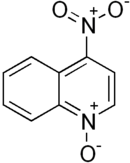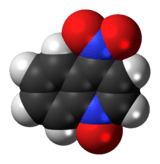4-Nitroquinoline 1-oxide
4-Nitroquinoline 1-oxide (also known as 4-NQO, 4NQO, 4Nqo, NQO and NQNO) is a quinoline derivative and a tumorigenic compound used in the assessment of the efficacy of diets, drugs, and procedures in the prevention and treatment of cancer in animal models. It induces DNA lesions usually corrected by nucleotide excision repair.
 | |
 | |
| Names | |
|---|---|
| IUPAC name
4-Nitroquinoline 1-oxide | |
| Identifiers | |
3D model (JSmol) |
|
| ChEBI | |
| ChEMBL | |
| ChemSpider | |
| ECHA InfoCard | 100.000.256 |
| KEGG | |
PubChem CID |
|
| UNII | |
CompTox Dashboard (EPA) |
|
| |
| |
| Properties | |
| C9H6N2O3 | |
| Molar mass | 190.16 g/mol |
| Appearance | yellow-brown crystals or powder |
| Melting point | 26 to 28 °C (79 to 82 °F; 299 to 301 K) |
| Boiling point | 237 to 243 °C (459 to 469 °F; 510 to 516 K) |
| slightly | |
| Hazards | |
| Main hazards | DANGER: CANCER RISK, causes blood, liver, and thyroid injury; causes DNA adducts |
| Flash point | 101 °C (214 °F; 374 K) |
| 400 °C (752 °F; 673 K) | |
Except where otherwise noted, data are given for materials in their standard state (at 25 °C [77 °F], 100 kPa). | |
| Infobox references | |
General
4-nitroquinoline 1-oxide (4NQO) is a quinoline, a carcinogenic and mutagenic chemical. Quinolines, like 4NQO, possess a heterocyclic aromatic structure and the same basic chemical formula of C9H7N.[1] 4NQO may naturally occur in the environment but is typically manufactured for research purposes.[2] 4NQO is known to mimic the biological effects of ultraviolet light on various organisms.[3] Both 4NQO and its reduced metabolite 4-hydroxyaminoquinoline 1-oxide (4HAQO) bind covalently to cellular macromolecules such as nucleic acids and proteins.[4]
4NQO has been shown to trap topoisomerase I cleavage complexes [5]. It may also induce DNA damage through the production of reactive oxygen species thought to arise from enzymatic reduction of its nitro group, although its exact mechanism is unknown.[6] 4NQO’s reactive oxygen species may serve as a byproduct of DNA damage or signaling molecule from damage.[7] In response to damage from 4NQO, cells attempt to repair and initiate a transcriptional response to detoxify the cell from 4NQO and its metabolites.[8]
Technical
DNA damage by 4NQO is a potent model. 4NQO induces DNA lesions usually corrected by nucleotide excision repair. 4NQO’s four electron reduction product, 4-hydroxyaminoquinoline 1-oxide (4HAQO), is believed to be a carcinogenic metabolite of 4NQO. When 4NQO is metabolized to its electrophilic reactant, selyl-4HAQO, it reacts with DNA to form stable quinolone monoadducts considered responsible for its mutagenicity and genotoxicity.[6]
The stable quinolone monoadducts oxidize to form 8-hydroxydeoxyguanosine (8OHdG), which, if left unrepaired, lead to transversions of guanines to thymines, which are nucleotides in DNA. Despite the direct mutagenic properties of 4HAQO, it is less toxic than 4NQO, indicating that metabolism of 4NQO produces other reactive chemicals such as anion radical metabolites.[7]
Yeast species have been used to map polymorphic regions in response to 4NQO, identifying the polymorphic transcription factor Yrr1. Yrr1 confers 4NQO resistance to wild-type S. cerevisiae yeast, binding upstream from core genes well-known to regulation drug response.[9] Yrr1 shifts cellular response in resistance to 4NQO and rates of respiration.[7]
References
- "Quinoline (Benzopyridine)".
- LaVoie, Edmond J.; Adams, Elisabeth Ann; Shigematsu, Akemi; Hoffman, Dietrich (September 1983). "On the metabolism of quinoline and isoquinoline: possible molecular basis for differences in biological activities". Carcinogenesis. 4 (9): 1169–73. doi:10.1093/carcin/4.9.1169. PMID 6883639.
- Ikenaga, Mituo; Ichikawa-Ryo, Haruko; Kondo, Sohei (1975). "The major cause of inactivation and mutation by 4-Nitroquinoline 1-Oxide in Escherichia coli: Excisable 4NQO-purine adducts". Journal of Molecular Biology. 92 (2): 341–56. doi:10.1016/0022-2836(75)90233-8. PMID 806692.
- Tada, Mitsuhiko; Tada, Mariko (1975). "Seryl-tRNA synthetase and activation of the carcinogen 4-nitroquinoline 1-oxide". Nature. 255 (5508): 510–2. Bibcode:1975Natur.255..510T. doi:10.1038/255510a0. PMID 166317.
- Miao, Z.H. (2006). "4-nitroquinoline-1-oxide induces the formation of cellular topoisomerase I-DNA cleavage complexes". Cancer Res. 66 (13): 6540–5. doi:10.1158/0008-5472.CAN-05-4471. PMID 16818625.
- Arima, Yaeno; Nishigori, Chikako; Takeuchi, Toru; Oka, Shigenori; Morimoto, Kanehisa; Utani, Atsushi; Miyachi, Yoshiki (2006). "4-Nitroquinoline 1-Oxide Forms 8-Hydroxydeoxyguanosine in Human Fibroblasts through Reactive Oxygen Species". Toxicological Sciences. 91 (2): 382–92. doi:10.1093/toxsci/kfj161. PMID 16547075.
- Gallagher, Jennifer E. G.; Zheng, Wei; Rong, Xiaoqing; Miranda, Noraliz; Lin, Zhixiang; Dunn, Barbara; Zhao, Hongyu; Snyder, Michael P. (2014). "Divergence in a master variator generates distinct phenotypes and transcriptional responses". Genes & Development. 28 (4): 409–21. doi:10.1101/gad.228940.113. PMC 3937518. PMID 24532717.
- Fry, Rebecca C.; Begley, Thomas J.; Samson, Leona D. (2005). "Genome-Wide Responses to DNA-Damaging Agents". Annual Review of Microbiology. 59: 357–77. doi:10.1146/annurev.micro.59.031805.133658. PMID 16153173.
- Le Crom, Stéphane; Devaux, Frédéric; Marc, Philippe; Zhang, Xiaoting; Moye-Rowley, W. Scott; Jacq, Claude (2002). "New Insights into the Pleiotropic Drug Resistance Network from Genome-Wide Characterization of the YRR1 Transcription Factor Regulation System". Molecular and Cellular Biology. 22 (8): 2642–9. doi:10.1128/MCB.22.8.2642-2649.2002. PMC 133742. PMID 11909958.